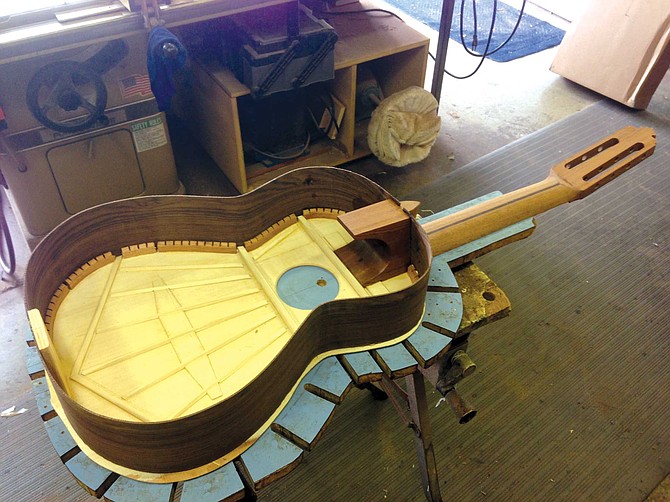 Facebook
Facebook
 X
X
 Instagram
Instagram
 TikTok
TikTok
 Youtube
Youtube

Having a custom guitar built just for you is every classical guitar player’s dream. As a performer and teacher for over 30 years, I have played (and owned) many fine guitars, but until I started working with Lennis Laviolette, I had never had one built according to my own specs. (Two woods for the soundboard? No problem!) A student of mine had a custom guitar made by Len, and I was so impressed that I called him up and met him at his workshop in Serra Mesa. He had several beautiful guitars already made: a spruce top with maple sides and back, and a cedar top with rosewood. Both sounded and played wonderfully. For me as a player, a guitar not only has to look and sound good, it also has to play well, meaning my fingers must feel a minimum amount of effort as I play the strings. Len’s guitars had all three; I was hooked.

Still, I wanted something a little different. I had been recording works for three or four guitars and was continually running into problems with the low range of the guitar. I wanted to reach down to a “C” the way a cello does, instead of the normal “E” or “D” that a guitar uses. I wanted an extra string. Over the next few months, I worked with Len, first deciding on an instrument with seven strings and no cutaway (the indentation some acoustic guitars have that allows access to the upper frets). He showed me a stunning piece of Brazilian Rosewood for the back and sides. We picked cedar and spruce for the top. On my guitar, Len used a technique called a double-top, where there are actually two soundboards, and we were able two use both Cedar and Spruce (the two most traditional woods for the soundboard) to create something new. I stopped in about once a week after that, choosing the tuner color, the rosette design, and even the wording on the label.
To commission a work of art such as my guitar was a new and surprisingly fun experience. Other than the shoe rack I once made to house my kids’ ever growing collection of footwear, I have never had success in making anything. I can’t draw, carve, whittle, or sculpt. But what I could do was imagine what my dream guitar might look like. I communicated this vision to Len as the weeks progressed, and the guitar took shape according to that vision. The curve of the sides of Brazilian Rosewood, the smell of the cedar top, the light marbling of the rosette’s wood, the feel of the neck as it was shaved to fit my hand — Len’s long experience in woodworking and love for the guitar made it all happen. (He is not only a luthier, but is also an active player in several local ensembles.) I felt understood, and grateful that I didn’t have to hold back with my long list of custom requests. I own (and love) many guitars, but seeing my seven-string built and then playing that first note — hearing its mellow, warm, beautiful tone for the first time — will always be something special.


Having a custom guitar built just for you is every classical guitar player’s dream. As a performer and teacher for over 30 years, I have played (and owned) many fine guitars, but until I started working with Lennis Laviolette, I had never had one built according to my own specs. (Two woods for the soundboard? No problem!) A student of mine had a custom guitar made by Len, and I was so impressed that I called him up and met him at his workshop in Serra Mesa. He had several beautiful guitars already made: a spruce top with maple sides and back, and a cedar top with rosewood. Both sounded and played wonderfully. For me as a player, a guitar not only has to look and sound good, it also has to play well, meaning my fingers must feel a minimum amount of effort as I play the strings. Len’s guitars had all three; I was hooked.

Still, I wanted something a little different. I had been recording works for three or four guitars and was continually running into problems with the low range of the guitar. I wanted to reach down to a “C” the way a cello does, instead of the normal “E” or “D” that a guitar uses. I wanted an extra string. Over the next few months, I worked with Len, first deciding on an instrument with seven strings and no cutaway (the indentation some acoustic guitars have that allows access to the upper frets). He showed me a stunning piece of Brazilian Rosewood for the back and sides. We picked cedar and spruce for the top. On my guitar, Len used a technique called a double-top, where there are actually two soundboards, and we were able two use both Cedar and Spruce (the two most traditional woods for the soundboard) to create something new. I stopped in about once a week after that, choosing the tuner color, the rosette design, and even the wording on the label.
To commission a work of art such as my guitar was a new and surprisingly fun experience. Other than the shoe rack I once made to house my kids’ ever growing collection of footwear, I have never had success in making anything. I can’t draw, carve, whittle, or sculpt. But what I could do was imagine what my dream guitar might look like. I communicated this vision to Len as the weeks progressed, and the guitar took shape according to that vision. The curve of the sides of Brazilian Rosewood, the smell of the cedar top, the light marbling of the rosette’s wood, the feel of the neck as it was shaved to fit my hand — Len’s long experience in woodworking and love for the guitar made it all happen. (He is not only a luthier, but is also an active player in several local ensembles.) I felt understood, and grateful that I didn’t have to hold back with my long list of custom requests. I own (and love) many guitars, but seeing my seven-string built and then playing that first note — hearing its mellow, warm, beautiful tone for the first time — will always be something special.
Comments